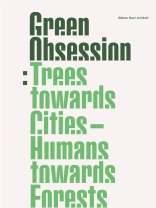Green Obsession traces the long path that architect Stefano Boeri and his studio – Stefano Boeri Architetti – have followed in the last fifteen years of practice, aiming at the redefinition of the relationship between city and nature. The book follows a discursive thread, alternating dialogues and scientific essays by some of the main protagonists who have contributed to widening the perspective on this subject, helping to raise awareness while protecting the world and its biodiversity.
Cities have contributed for centuries to the promotion of some of humanity’s greatest ideas, we must now urgently include them as among the principal players in the environmental debate and at the forefront of any policy tackling and countering – possibly reversing – climate change. Nevertheless, even today one of the most significant technologies capable of absorbing CO2 and restoring our environment is photosynthesis. Planting trees, in addition to protecting existing natural areas and biodiversity, together with de-carbonization, renewable energies, digitalization, smart mobility and the circular economy could be the set of strategies necessary to tackle climate change.
Today the effects of the Anthropocene age are ever more visible, changing our environment and affecting every species that lives within it. Green Obsession offers a path to be taken, a hard but still necessary paradigm shift – even for architecture and urbanism – that aims to give a voice to this much needed ecological transition.
This book aims to unveil the processes and the complexity involved in the search for a new kind of urbanism, while raising questions and opening old wounds related to the relationship between the human species and Nature and finally putting these fragments together to create a portrait of our era. We need to conceive cities as new green catalysts. Now more than ever, it is essential to act together as separate individuals and professionals, joining the cause as members of the global community with a shared environmental strategy. We all have to open the era of a new alliance between Nature and City.
With Contributions from Emanuele Coccia, Jane Goodall, Paul Hawken, Cecil Konijnendijk, David Miller, Harini Nagendra, Giuseppe Sala and Giorgio Vacchiano.’
Circa l’autore
Architect and urban planner, Stefano Boeri has been Professor at the Politecnico in Milan and visiting Professor at several international universities, including Harvard University’s Graduate School of Design (GSD), the Strelka Institute in Moscow, the Berlage Institute in the Netherlands and the École Polytechnique Fédérale de Lausanne. In Shanghai, he is Director of the Future City Lab at Tongji University: a post-doctoral research program that explores the future of contemporary metropolises under the perspectives of biodiversity and urban forestry.
In November 2018, he was Co-Chair of the Scientific Committee for the first World Forum on Urban Forests, organized in Mantua together with the FAO (Food and Agriculture Organization, UN). In 2019 he presented in New York the Great Green Wall of Cities project, developed with FAO, C40, UN-Habitat e other international research organizations, on the occasion of the UN Climate Action Summit 2019.
Author of several books and publications, Stefano Boeri was Councilor for Culture in Milan (from 2011 to 2013) and in February 2018 he was appointed President of Fondazione Triennale Milano, a major international cultural institution based in Milan that produces exhibitions, conferences and events dedicated to architecture, art, design, fashion, cinema, and graphics.












